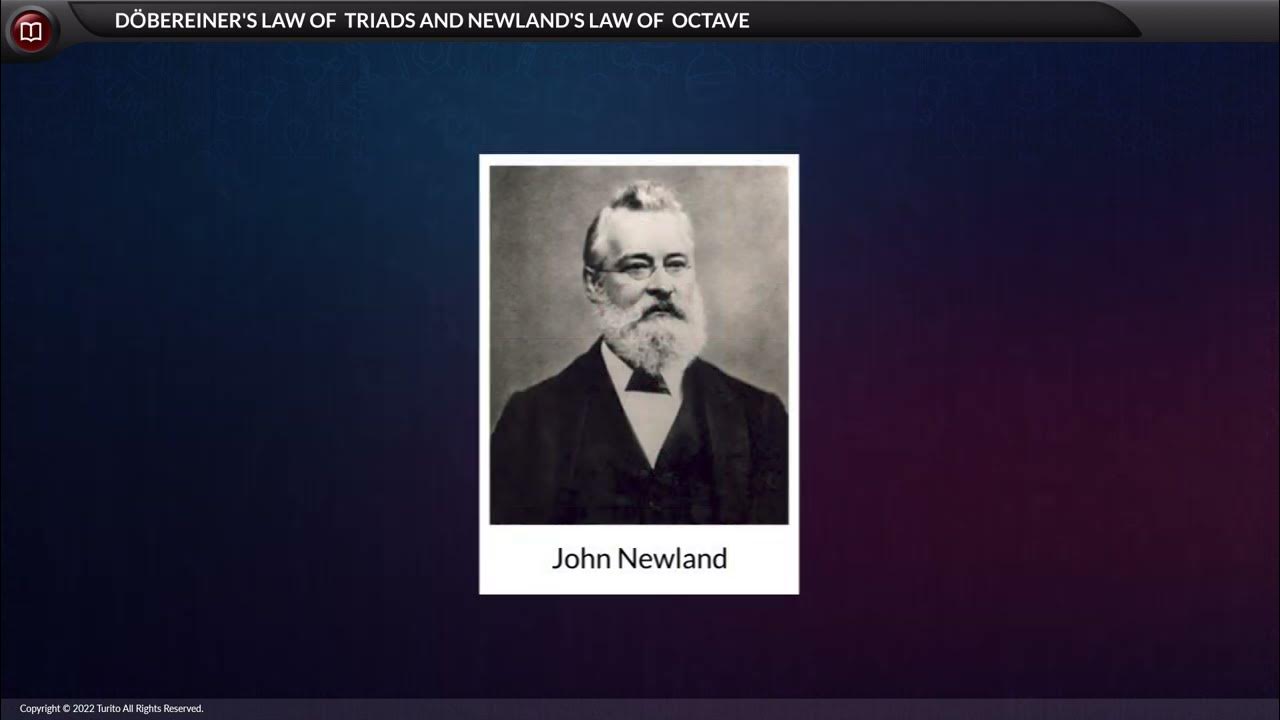History of Periodic Table Animation
Summary
TLDRThis script traces the evolution of the periodic table, starting with Johann Wolfgang Dobereiner's triads to John Newlands' octaves. It highlights Dmitri Mendeleev's foundational work, introducing his periodic law and the first periodic table with 63 elements. The script also discusses the limitations of early classifications and the pivotal shift to atomic numbers by Henry Moseley, leading to the modern periodic table. The summary encapsulates the quest for understanding element properties and their organization.
Takeaways
- 🔬 The script discusses the history and development of the periodic table, starting with early attempts to classify elements based on their properties.
- 👨🔬 Johann Wolfgang Dobereiner identified groups of three elements with similar properties in 1829, which was an early but primitive step in the classification of elements.
- 📊 John Newlands, a British chemist, arranged 56 elements in increasing order of atomic mass and noticed a pattern, which he called the 'Law of Octaves', but this system had limitations and couldn't accommodate all elements.
- 🌟 Dmitri Mendeleev's periodic table was a significant advancement, as he considered both atomic mass and chemical properties, creating a table with 63 elements and predicting properties of yet-to-be-discovered elements.
- 🧩 Mendeleev's periodic law stated that the properties of elements are a periodic function of their atomic masses, leading to the horizontal rows called 'periods' and vertical columns called 'groups'.
- 🔍 Mendeleev left blank spaces for elements that were yet to be discovered, and when they were found, they fit into his table, validating his predictions.
- 🚫 The script mentions some of the shortcomings of Mendeleev's table, such as the placement issues with hydrogen and elements with similar properties being placed in different groups.
- 🔢 Henry Moseley's discovery in 1913 that atomic number, not atomic mass, is the fundamental property of an element revolutionized the understanding of the periodic table.
- 📚 The modern periodic law, based on atomic number, led to the creation of the modern periodic table, which is the most commonly used version today.
- 🌐 The modern periodic table is structured with seven periods and eighteen groups, offering a more accurate classification of elements based on their properties.
- 📈 The script concludes by emphasizing the importance of the modern periodic table in understanding the properties and behaviors of elements.
Q & A
Who was the first scientist to attempt classifying elements based on their properties?
-Johann Wolfgang Dobereiner was the first scientist to attempt classifying elements based on their properties, identifying groups of three elements with similar properties in 1829.
What was the name of the classification system proposed by John Newlands, and what was its main flaw?
-John Newlands proposed the 'Law of Octaves,' which arranged elements in order of increasing atomic mass and found that every eighth element had properties similar to the first. The main flaw was that it could only arrange elements up to calcium, and later discovered elements did not fit the pattern.
What was Mendeleev's contribution to the classification of elements, and what was his periodic law?
-Dmitri Mendeleev created the first periodic table, arranging known elements in increasing order of their atomic masses and properties. Mendeleev's law states that the physical and chemical properties of elements are a periodic function of their atomic masses.
How did Mendeleev's periodic table accommodate the discovery of noble gases?
-When noble gases were discovered, they were placed in the Mendeleev table without disturbing the position of other elements, demonstrating the flexibility and accuracy of his classification system.
What irregularities were present in Mendeleev's periodic table that indicated the need for a new classification?
-In Mendeleev's table, there were issues such as the placement of elements with higher atomic mass before those with lower atomic mass (e.g., cobalt before nickel), and elements with different properties being placed in the same subgroup (e.g., manganese and magnesium).
Who discovered that atomic number, rather than atomic mass, is the most fundamental property of an element?
-Henry Moseley, an English physicist, discovered in 1913 that atomic number is the most fundamental property of an element, leading to the modern periodic law.
What is the modern periodic law, and how does it differ from Mendeleev's law?
-The modern periodic law states that the chemical and physical properties of elements are a periodic function of their atomic numbers, rather than their atomic masses as proposed by Mendeleev.
What is the structure of the modern periodic table, and how does it differ from Mendeleev's original table?
-The modern periodic table is structured with seven periods (horizontal rows) and 18 groups (vertical columns), including the 8 main groups and additional groups for transition metals and noble gases. It differs from Mendeleev's table by being organized primarily by atomic number rather than atomic mass.
Why was there initially no fixed position for hydrogen in the periodic table?
-Hydrogen's position was initially uncertain because it resembles both alkali metals and halogens, making it difficult to categorize within the periodic table.
How did Mendeleev predict the properties of yet-to-be-discovered elements, and were his predictions accurate?
-Mendeleev left blank spaces in his periodic table for elements that were yet to be discovered and named them (e.g., gallium, scandium). He predicted their properties based on the pattern of the table, and these predictions were later found to be correct.
Outlines

このセクションは有料ユーザー限定です。 アクセスするには、アップグレードをお願いします。
今すぐアップグレードMindmap

このセクションは有料ユーザー限定です。 アクセスするには、アップグレードをお願いします。
今すぐアップグレードKeywords

このセクションは有料ユーザー限定です。 アクセスするには、アップグレードをお願いします。
今すぐアップグレードHighlights

このセクションは有料ユーザー限定です。 アクセスするには、アップグレードをお願いします。
今すぐアップグレードTranscripts

このセクションは有料ユーザー限定です。 アクセスするには、アップグレードをお願いします。
今すぐアップグレード関連動画をさらに表示

Perkembangan Sistem Periodik Unsur

PERKEMBANGAN SISTEM PERIODIK UNSUR | Kimia Kelas X | Terlengkap dan Mudah dipahami| Prof. Aira

Perkembangan Tabel Periodik Unsur Kimia Kelas 10

Aula 23 - História da Tabela Periódica - Help Química

Chemistry - Grade 9 - The periodic table - Dobereiner's law of Triads and Newland's law of octave

Perkembangan Sistem Periodik Unsur | KIMIA KELAS 10
5.0 / 5 (0 votes)
